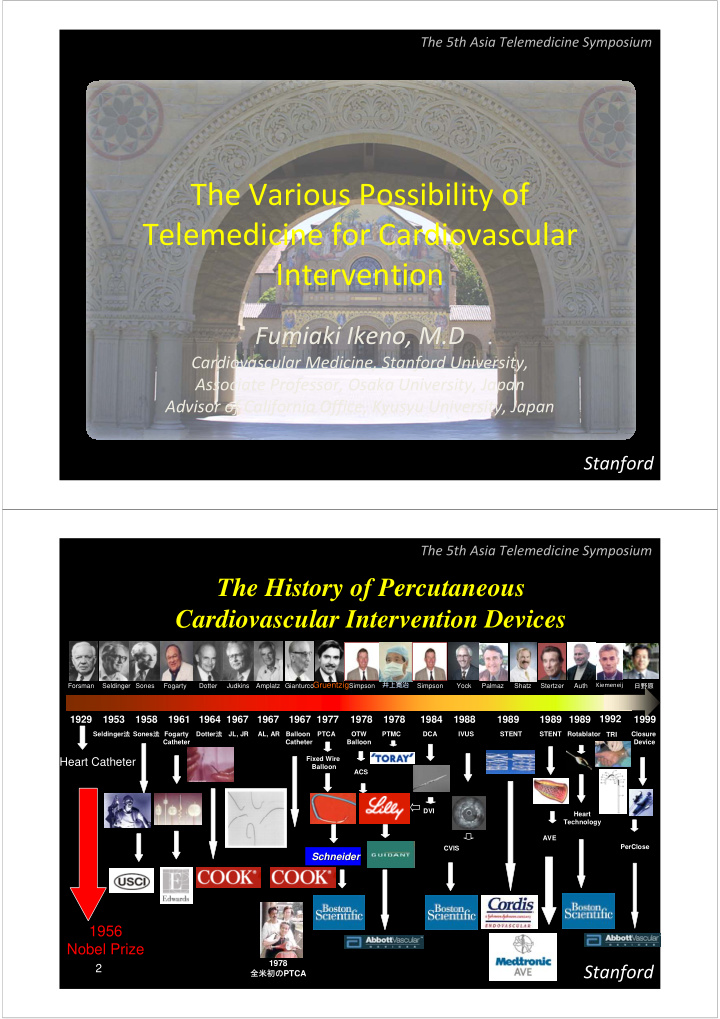



The 5th Asia Telemedicine Symposium The Various Possibility of Telemedicine for Cardiovascular Intervention Fumiaki Ikeno, M.D Cardiovascular Medicine, Stanford University, Associate Professor, Osaka University, Japan Advisor of California Office, Kyusyu University, Japan Stanford The 5th Asia Telemedicine Symposium The History of Percutaneous Cardiovascular Intervention Devices 井上寛治 井上寛治 Gruentzig Kiemeneij Forsman Seldinger Sones Fogarty Dotter Judkins Amplatz Gianturco Simpson Simpson Yock Palmaz Shatz Stertzer Auth 日野原 1978 1929 1953 1958 1961 1964 1967 1967 1967 1977 1978 1978 1984 1988 1989 1989 1989 1992 1999 Seldinger 法 Sones 法 Dotter 法 Fogarty JL, JR AL, AR Balloon PTCA OTW PTMC DCA IVUS STENT STENT Rotablator Closure TRI Catheter Catheter Balloon Device Heart Catheter Fixed Wire Balloon ACS DVI Heart Technology AVE PerClose CVIS Schneider Schneider 1956 Nobel Prize 1978 2 Stanford 全米初の PTCA
The 5th Asia Telemedicine Symposium Coronary Artery Angioplasty has started in 1977. Andreas Roland Grüntzig (1939–1985) Stanford The 5th Asia Telemedicine Symposium But, at first, nobody believed angioplasty worked! He started the educational course in order to spread the angioplasty all over the world. Stanford
The 5th Asia Telemedicine Symposium Since then, Live demonstration is the standard way for the education of angioplasty! Stanford The 5th Asia Telemedicine Symposium Nowadays, the angioplasty is Nowadays, the angioplasty is introduced into any other arteries. introduced into any other arteries. Peripheral arteries Renal arteries Carotid arteries Stanford
The 5th Asia Telemedicine Symposium The History of Percutaneous Cardiovascular Intervention Devices 2001 2011 Drug Eluting Stent Stanford 7 The 5th Asia Telemedicine Symposium Transcatheter Intervention Transcatheter Intervention for Structural Heart Disease for Structural Heart Disease PDA Pulmonary Valve ASD 、 PFO LAA Aortic Valve Mitral Valve Tricuspid Valve VSD Stanford
The 5th Asia Telemedicine Symposium Edwards-SAPIEN XT Approach Bovine Tissue, Cobalt Frame Trans Femoral Trans Apical 18 Fr Balloon Expandable 9 The 5th Asia Telemedicine Symposium Edwards-SAPIEN: Trans Femoral 10
The 5th Asia Telemedicine Symposium Current Devices for Percutaneous Mitral valve Intervention Coronary Sinus AV grove Cinching Edge to edge Approach Approach Apporach MONARC™ MITRALIGN Inc OuantumCor Inc (Edward LifeSciense) Accucinch TM Cordis Corp PTMA™ (Guided Delivery Systems) (Viacor, Inc) Mitral Valve Replacement Mitra Clip CARILLON™ (Cardiac Dimension, Inc) EndoValve, Inc 11 The 5th Asia Telemedicine Symposium Mitra Clip 12
The 5th Asia Telemedicine Symposium Mitra Clip 13 The 5th Asia Telemedicine Symposium
The 5th Asia Telemedicine Symposium Application of Telemedicine in Cardiovascular Catheter Intervention 1. Education 2. Consultation 3. Conference Stanford The 5th Asia Telemedicine Symposium Toyohashi Heart Center Stanford
The 5th Asia Telemedicine Symposium Telemedicine for Cardiovascular Intervention Live Demonstration of New Devices Stanford The 5th Asia Telemedicine Symposium Telemedicine for Cardiovascular Intervention Specific Issue in Japan Stanford
The 5th Asia Telemedicine Symposium We can use the We can use the new devices new devices From the standpoint of physicians……… ……….. .. From the standpoint of physicians after our large after our large We can use We can use pivotal trial in pivotal trial in the newest the newest the USA. But the USA. But devices the devices the these days, it is these days, it is first in the first in the becoming becoming world! world! slower. slower. GDP: No.1 We are the last We are the last country that country that GDP: No.3 (1968-2009: No2) can use new can use new devices, but at devices, but at that time, no that time, no more new! more new! But patients are waiting for more effective devices! But patients are waiting for more effective devices! This is universal wish for patients…… …….. .. This is universal wish for patients Stanford “Device Lag” for TAVI REVIVE-2 E-REVIVE/RECAST Feasibility, n=36 Feasibility, n=90 SAPIEN SAPIEN SAPIEN SAPIEN XT First in REVIVAL-2 Feasibility, n=77 Man SAPIEN Edwards-SAPIEN US PIVOTAL, n=600 SAPIEN 治 Edwards-SAPIEN XT 験 N=60 CHIKEN SAPIEN XT Germany Registry Feasibility, n=86 First in US Pivotal Man Trial N=1300 Medtronic CoreValve 2002 2004 2006 2008 2010 Now Under investigation in EU 20
“Device Lag” for Mitral valve Intervention First in EVEREST-I EVEREST-II Feasibily, n=107 Man US PIVOTAL, n=279 Mitra Clip TM (eValve/ABBOTT) EU FIM N=30 AMADEUS TITAN First N=30 N=36 in Man CARILLON™ (Cardiac Dimension, Inc) 2003 2005 2007 2009 Now Under investigation in EU & Latin America 21 The 5th Asia Telemedicine Symposium Telemedicine for Cardiovascular Intervention We, Japanese, need to learn the new treatment from outside of Japan! Stanford
The 5th Asia Telemedicine Symposium The same species, but………….. Stanford The 5th Asia Telemedicine Symposium Telemedicine for Cardiovascular Intervention We, Asian, need to discuss the new treatment by ourselves! Stanford
The 5th Asia Telemedicine Symposium Telemedicine for Cardiovascular Intervention Future, but not so far! Stanford Gaming Industry: “Wii” of Medicine Today’s 30 yo is much better at “hand – eye” Stanford Stanford Courtesy from Prof. Peter Fitzgerald
Valves: The “touch” of a surgeon in the Cath Lab Courtesy from Prof Peter Fitzgerald Robotic Catheter System Robotic Catheter System Catheter Management Catheter Management Patient Patient MD Teaching MD Teaching Consistency Consistency & Training & Training Stanford Stanford Courtesy from Prof. Peter Fitzgerald
Robotic Catheter System Robotic Catheter System (training and planning for the procedure) (training and planning for the procedure) Routine Catheter Movement Routine Catheter Movement Complex Catheter Movement Complex Catheter Movement Standardization Facilitation Standardization Facilitation Stanford Courtesy from Prof. Peter Fitzgerald Stanford The 5th Asia Telemedicine Symposium Stanford Courtesy from Prof. Peter Fitzgerald
The 5th Asia Telemedicine Symposium In the cardiovascular fields, we need the brainstorming to conjugate the telemedicine! We believe telemedicine will improve the daily practice of this fields and help the patients! Stanford
Recommend
More recommend